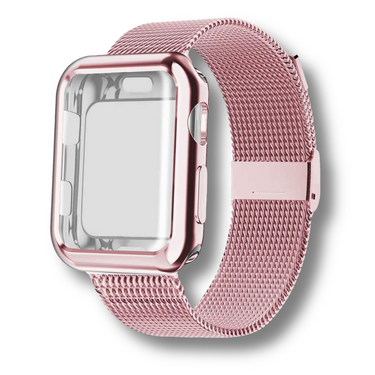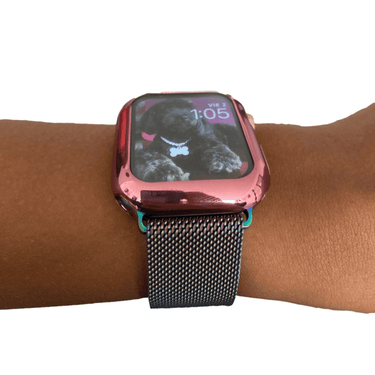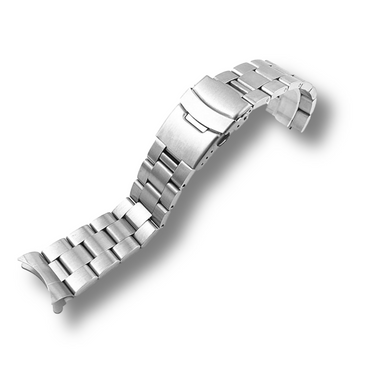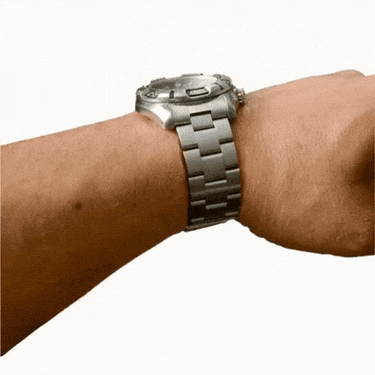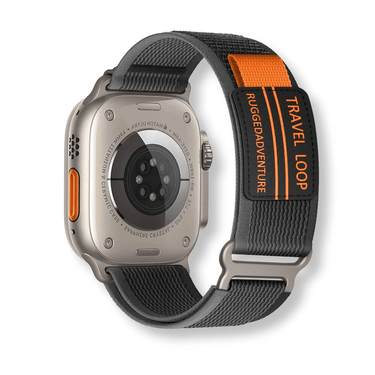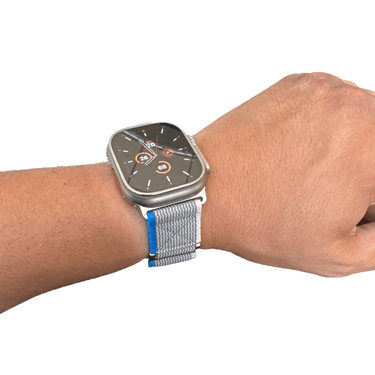The Apple Watch has taken the world by storm since its initial release in 2015. With its sleek design, advanced features, and seamless integration with other Apple devices, it has become a must-have accessory for tech enthusiasts and fashion-forward individuals alike.
The Apple Watch has transformed the way we interact with our smartphones, providing convenience right at our fingertips. As the demand for this cutting-edge wearable continues to grow, so does the range of options available to consumers.
One crucial decision that every potential buyer must make is choosing the perfect size for their Apple Watch. While it may seem like a minor detail, selecting the right size can greatly impact your overall comfort and functionality.
Brief overview of the Apple Watch and its popularity
The Apple Watch is a smartwatch that combines style and functionality seamlessly. It offers an array of features designed to enhance daily life such as fitness tracking, heart rate monitoring, messaging capabilities, music streaming, and much more.
Powered by powerful processors and equipped with various sensors, this device serves as an extension of your iPhone or iPad. Since its release, the Apple Watch has gained immense popularity across different demographics.
Its sleek design coupled with customizable watch faces and interchangeable bands have made it a fashion statement. Additionally, its integration with various health apps has made it appealing to fitness enthusiasts who seek to track their activity levels seamlessly.
The ability to send quick messages or make calls directly from your wrist without having to reach for your phone has added unmatched convenience to everyday life. Whether you're navigating through busy city streets or simply want quick access to notifications without constantly checking your phone, the Apple Watch delivers unparalleled accessibility.
Importance of choosing the right size for optimal comfort and functionality
When purchasing an Apple Watch, one-size-fits-all is not the case. Apple offers a range of sizes to cater to different wrist dimensions and personal preferences. Choosing the correct size is crucial for ensuring optimal comfort and enhancing your overall experience with the device.
Comfort plays a significant role in wearing any watch, and the Apple Watch is no exception. A well-fitted watch should feel like an extension of your wrist rather than a cumbersome accessory.
Selecting the appropriate size ensures that you can wear your Apple Watch for extended periods without discomfort or irritation. Functionality is another critical factor impacted by size selection.
The screen size, layout, and user interface differ slightly across various Apple Watch sizes. Choosing a size that suits your needs helps ensure that you can navigate through apps, view notifications, read messages, and interact with the device effortlessly.
To make an informed decision on which size best suits you, it's essential to delve into each available option's specifics while considering factors such as wrist size, personal style preferences, and daily activities. By doing so, you can find the perfect fit that seamlessly integrates into your lifestyle while enhancing both comfort and functionality.
Understanding Apple Watch Sizes
When embarking upon the journey of selecting an Apple Watch, it is crucial to first grasp a comprehensive understanding of the available sizes. Apple offers its coveted timepiece in four distinct sizes: 38mm, 40mm, 42mm, and 44mm.
These measurements pertain to the height of the watch case, specifically from top to bottom. While seemingly slight variances, these differences can profoundly impact your overall user experience.
Overview of Available Sizes: 38mm, 40mm, 42mm, and 44mm
The smallest option available is the dainty yet compelling Apple Watch with a case height of either 38mm or its updated counterpart measuring at an even sleeker height of 40mm. On the other hand (or wrist), those seeking a more substantial presence on their arm may opt for the slightly larger options—either the classic sizing with a case height of 42mm or its more recent iteration standing tall at precisely 44mm.
The case size selection directly influences various aspects such as display size, visibility, and comfort level. In considering these factors meticulously during your decision-making process, you can ensure that your chosen timepiece aligns harmoniously with both your aesthetic preferences and functional needs.
Evolution of Apple Watch Sizes over the Years
To appreciate fully how Apple has refined their watches throughout time, it's necessary to delve into their evolutionary journey regarding sizes. The initial release in April 2015 marked their entrance into this highly competitive market with two primary sizes: a smaller model measuring at only 38mm and a larger variant coming in at a still-modest size of 42mm. As demand grew exponentially for this innovative wearable technology gemstone created by Apple's ingenious craftsmen, the company responded by introducing enhanced sizing options.
In 2018, the case height witnessed a slight reduction with the introduction of a new size: 40mm, replacing the 38mm variant. Simultaneously, the larger option expanded marginally to 44mm, providing users with an even more immersive experience.
Apple's meticulous dedication to continuously reassessing and refining their watch sizes ensures that they cater to a wide range of discerning consumers seeking optimal satisfaction. By staying attuned to trends and consumer preferences while leveraging technological advancements, Apple consistently delivers watches that harmonize style and functionality—captivating both long-standing devotees and newcomers alike.
Now armed with an understanding of the available sizes and how they have evolved over time, it is time to move forward in this quest for the perfect Apple Watch fit. Let us delve further into the critical factors you should consider when selecting your ideal size based on your wrist dimensions and personal style preferences.
Factors to Consider when Choosing the Size
Wrist Size and Shape: Measuring Your Wrist Accurately
When it comes to choosing the perfect size for your Apple Watch, understanding your wrist size and shape is paramount. A precise measurement will help ensure optimal comfort and prevent any discomfort or unwanted sliding during daily wear. To measure your wrist accurately, you can use a tape measure or a printable sizing guide provided by Apple's official website.
Using a tape measure is relatively straightforward. Start by wrapping the tape measure snugly around the widest part of your wrist, just below the bone protrusion on your hand's side.
Ensure that it's not too tight or too loose, as an inaccurate measurement may lead to an ill-fitting watch size. Alternatively, Apple offers printable sizing guides that can be downloaded from their website.
These guides include cutouts that help you determine which size suits your wrist best. After printing, select the appropriate cutout based on your preference (38mm/40mm or 42mm/44mm), then carefully align it with your wrist until you find the perfect fit.
How to Determine if You Have a Small, Medium, or Large Wrist
Once you have measured your wrist accurately using either method described above, you can evaluate whether you have a small, medium, or large wrist circumference based on industry standards. For instance, a small wrist typically measures around 5.5 to 6 inches (14-15 cm) in circumference. This category often suits individuals with petite builds who prefer daintier accessories that do not overpower their wrists.
A medium-sized wrist typically falls within the range of 6 to 7 inches (15-18 cm). This category encompasses a significant portion of individuals who are neither particularly slender nor large-wristed.
On the other hand, individuals with larger wrists often measure around 7 inches (18 cm) or above. Watch wearers in this category may prefer larger-sized timepieces to achieve a well-proportioned look and ensure comfortable wear.
Personal Style Preferences: Considering Your Fashion Sense and Daily Activities
Choosing the perfect Apple Watch size is not solely about practicality; it also involves aligning with your personal style preferences and the activities you engage in daily. Different sizes can complement various styles, allowing you to express yourself fashionably while enjoying the watch's functionality. For those who embrace a sporty aesthetic, smaller watch sizes such as 38mm or 40mm can provide a sleek and streamlined appearance that perfectly matches an active lifestyle.
These sizes tend to be lighter on the wrist, ensuring ease of movement during workouts or outdoor activities. On the other hand, if you lean towards an elegant or sophisticated fashion sense, larger watch sizes such as 42mm or 44mm might be more suitable.
These sizes offer a bolder presence on the wrist, making a statement and adding an air of luxury to your ensemble. It is also crucial to consider how different watch band options interact with your chosen Apple Watch size.
Whether you opt for classic leather bands, vibrant sport bands, or stylish metal bracelets, each band style will harmonize differently with varying watch sizes. Experimenting with different combinations will allow you to find the perfect balance between comfort and aesthetics that aligns with your unique tastes.
When selecting the ideal size for your Apple Watch, take into account both objective factors like wrist size measurements and subjective aspects like personal style preferences. By understanding these factors comprehensively and considering how different sizes complement various fashion styles and daily activities, you'll be well-equipped to make an informed decision that ensures optimal comfort and enhances your overall aesthetic appeal.
The Case for Smaller Sizes (38mm/40mm)
Advantages:
Smaller sizes of the Apple Watch, such as 38mm and 40mm, have their own set of unique advantages that make them an appealing choice for certain individuals. Firstly, these smaller sizes are lightweight and comfortable, providing a pleasant wearing experience especially for those with petite wrists or anyone who prefers a more minimalistic design aesthetic. The sleek and compact form factor allows the watch to seamlessly blend with your wrist without feeling bulky or cumbersome.
Furthermore, navigating through the Apple Watch interface becomes even easier with smaller fingers or if you require a high level of precision in your daily activities. The reduced size means that buttons and app icons are closer together, requiring less finger movement to access various functions.
This can be particularly advantageous for individuals engaged in tasks that demand fine motor skills like drawing on a digital canvas or tapping out precise messages. Another advantage of opting for smaller sizes is the increased comfort during physical activities.
The lower weight distribution on your wrist provides enhanced freedom of movement, making it suitable for athletic pursuits like running, cycling, or weightlifting where flexibility is key. Moreover, these compact watches fit snuggly against your wrist, reducing the chance of snagging on clothing or equipment during exercise.
Disadvantages:
While there are notable advantages to choosing smaller sizes of the Apple Watch, it is important to consider their limitations as well. One significant drawback is the limited screen real estate available on these watches. With a smaller display area compared to their larger counterparts, such as the 42mm and 44mm models, there is less space to present content such as texts or apps comfortably.
This can result in crowded visuals and potentially make it more challenging to read small text or navigate complex interfaces. The smaller size may also pose potential strain on eyesight due to the relatively compact text size.
Individuals with visual impairments or those who struggle with small fonts may find it more difficult to read notifications, messages, or other on-screen information without additional zooming or squinting. It is important to consider your personal visual acuity and any potential discomfort that may arise from prolonged use of smaller text.
It is also worth noting that the battery life on smaller sizes may be slightly shorter due to the limited physical space available for a battery. While Apple has made great strides in optimizing power efficiency across all models, those who heavily rely on their Apple Watch throughout the day may need to recharge more frequently compared to larger-sized variants.
Smaller sizes of the Apple Watch offer several advantages such as lightweight comfort and enhanced precision for certain users. They are particularly suitable for individuals with petite wrists or those seeking a sleek and minimalistic design.
However, it's crucial to keep in mind that these watches come with limitations including limited screen real estate for content display and potential strain on eyesight due to smaller text size. Ultimately, choosing the perfect Apple Watch size requires considering your personal preferences, wrist size, daily activities, and visual needs to ensure an optimal experience.
The Case for Larger Sizes (42mm/44mm)
Advantages:
When it comes to choosing the perfect Apple Watch size, opting for a larger size, such as the 42mm or 44mm variant, offers several noteworthy advantages. Perhaps the most prominent advantage lies in the amplified display area that these larger sizes provide. With a bigger screen real estate, users can enjoy enhanced content visibility and readability.
Whether you frequently read texts, emails, or engage with various apps on your Apple Watch, the larger display allows for a more immersive experience. Additionally, individuals with larger wrists will find that these bigger sizes offer a more proportionate look.
The 42mm and 44mm Apple Watch models have wider bands and cases that nicely complement individuals with broader wrists. By opting for a larger size, you can achieve a balanced aesthetic that seamlessly integrates with your wrist's dimensions.
Disadvantages:
While there are several advantages to embracing larger Apple Watch sizes, it is essential to consider potential downsides as well. One notable disadvantage of opting for a bigger size is its weight and bulkiness compared to their smaller counterparts. The increased surface area naturally leads to additional weight, which may be noticeable during extended periods of wear or physical activities.
Furthermore, individuals who prefer a sleek and compact design may find that the larger sizes don't align with their style preferences. If you have a smaller wrist or simply tend to gravitate towards minimalistic aesthetics, the 42mm or 44mm models might appear visually overwhelming.
Conclusion
When choosing an Apple Watch size that suits you best, considering both personal preferences and practical aspects is crucial. While larger sizes like the 42mm and 44mm offer benefits such as amplified display areas and proportionate looks for those with bigger wrists; they also come with potential drawbacks, including added weight and potentially overwhelming aesthetics for individuals with smaller wrists.
Ultimately, finding the perfect balance between comfort, functionality, and style is key. Embrace the versatility of the Apple Watch lineup and select a size that not only complements your wrist but also aligns with your lifestyle.
Remember that it's important to try on different sizes in person if possible to gauge how they feel and appear on your wrist. By carefully considering all aspects, you can confidently make an informed decision that ensures a delightful Apple Watch experience tailored specifically to you.












